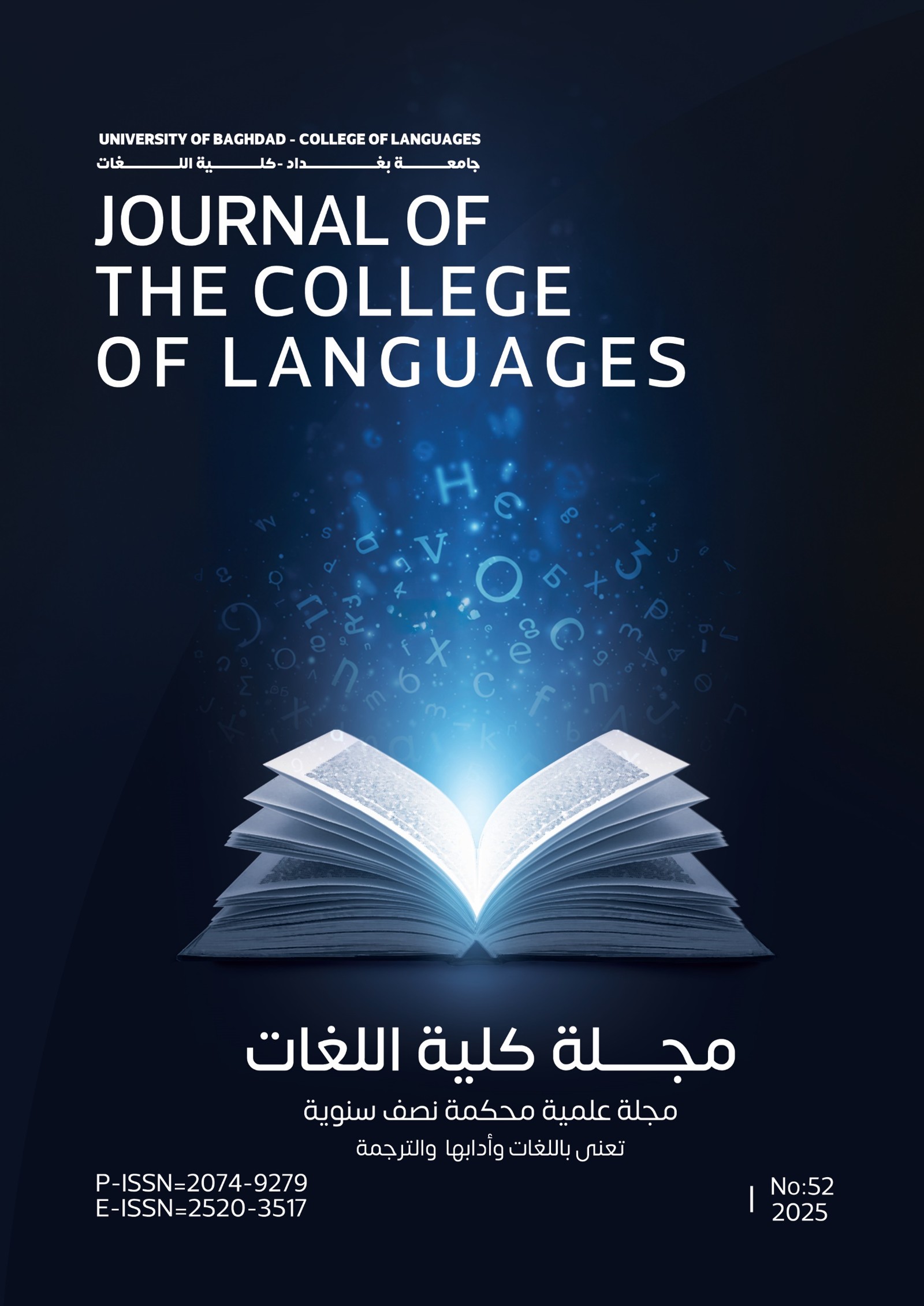A Critical Discourse Analysis of Love and Grief in Rumi’s Selected Poems
DOI:
https://doi.org/10.36586/jcl.2.2025.0.52.0085Keywords:
Fairclough’s three-dimensional model of CDA, Figurative language, Grief, Love, Ideology, Rumi’s poetryAbstract
This study tackles the concepts of love and grief within the framework of Sufi and Islamic contexts to identify how figures of speech are deployed to explore the themes of love and grief and their interconnectivity in Rumi’s selected poems. The study also aims to unlock the ideological implications in relation to these two themes and their relationship in the poems. Consequently, Fairclough’s three-dimensional model of Critical Discourse Analysis (henceforth CDA) is adopted in this study to conduct a critical discourse analysis of two selected poems from Jalalluddin Rumi’s translated poetic collection entitled The Book of Love: Poems of Ecstasy and Longing, using three levels of analysis; textual, discursive and social. The results reveal that Rumi deploys a preponderant and diverse range of figures of speech which include metaphor, personification, contrast, hyperbole, rhetorical question, symbol, simile, allusion and repetition. This is in order to intensify the crucial interconnectivity of love and grief during the individual’s spiritual experience of divine love that can only thrive on sacrifice, hardships and tribulations that cultivate and motivate lovers to gain self-maturity in seeking for spiritual union. Therefore, grief is figuratively represented by Rumi as a motivational and transformative element that accompanies love on its indescribable, experiential and spiritual path. Similarly, the three-dimensional analysis of this interconnectivity unveils a set of implied Islamic ideologies and some universal teachings as well which calls for reconsidering the common Western idea of classifying Rumi’s works as love poetry.
References
Abbaspour, B. N., Mahadi, T. S. T., & Zulkali, I. (2021). Ideological manipulation of translation through translator’s comments: A case study of Barks’ translation of Rumi’s poetry. Pertanika J. Soc. Sci. & Hum., 29(3), 1831-1851. doi: https://doi.org/10.47836/pjssh.29.3.19
Adegbenro, E.J. (2025). Style and ideology in Jonathan’s No Enemies to Fight: Goodluck Jonathan on the Marble. Journal of the College of Languages, (51), 1-18. doi: https://doi.org/10.36586/jcl.2.2025.0.51.0001
Al-Doori, M. (2021). The mystical and Sufi experience in selected poems by Rumi and W.B. Yeats (Master’s thesis). Retrieved from http://acikerisim.karabuk.edu.tr:8080/xmlui/bitstream/handle/123456789/1273/10400306.pdf?sequence=1&isAllowed=y
Al-Mas’udi, H. H. B., & Al-A’mery, A. S. A. (2021). Fairclough and Van Dijk models of critical discourse analysis. Adab Al-Kufa Journal, 47(2), 478-490. doi:10.36317/kaj/2021/v1.i48.537
Al-Qudsy, B. W. (2016). A stylistic analysis of figures of speech in the Jakarta post headlines under the issue of KPK vs. Polri (Master’s thesis). Retrieved from https://core.ac.uk/download/pdf/78027133.pdf
Amoussou, F., & Allagbe, A. A. (2018). Principles, theories and approaches to critical discourse analysis. International Journal on Studies in English Language and Literature (IJSELL), 6(1), 11-18. doi: http://dx.doi.org/10.20431/2347-3134.0601002
Ardiansyah, M. F., & Ayu, H. R. S.S. (n.d). Symbolism in Jalal Al-Din Rumi’s the book of love, chapter nine: Absence. Jurnal Mahasiswa Universitas Surabaya. Advance online publication. Retrieved from https://ejournal.unesa.ac.id/index.php/litera-kultura/article/download/9192/9136/12228
Aydin, E. (2004). Whispers of love: Mevlana Jelaleddin Rumi. Retrieved from https://www.dialoguesociety.org/assets/publications/mevlana-jelaladdin-rumi.pdf
Barks, C. (2003). Rumi: The book of love: Poems of ecstasy and longing. USA: Harper Collins Publishers.
Basuki, E.P., & Saputri, T. (2021). Analysis of figurative language of Jalaluddin Rumi’s poems in the Book of Love poems book. Education and Human Development Journal, 6(2), 93-104. doi: 10.33086/ehdj.v6i2
Behtash, E.Z. (2017). Images of ‘love’ and ‘death’ in the poetry of Jaláluddin Rumi and John Donne. International Journal of Applied Linguistics & English Literature, 6(2), 97-105. doi: 10.7575/aiac.ijalel.v.6n.2p.97
Beldi, N., Slimani, S., & Cherchali, O. Z. (2021). Norman Fairclough’s three dimensional approach as an analytical model in the critical discourse analysis of George Orwell’s novel Nineteen-Eighty Four (Master’s thesis). Retrieved from http://dspace.univ-medea.dz/bitstream/123456789/6561/1/MME.62-63.pdf
Burhanudin, H., Sumarlam, & Rakhmawati, A. (2021). The dimensionality on the mayor of Surakarta’s (2016-2021) Javanese covid-19 posters. Humaniora 12(2), 161-171. doi: 10.21512/humaniora.v12i2.7009
Fairclough, N. (1989). Language and power [DX Reader version]. Retrieved from https://www.okehamptoncollege.devon.sch.uk/uploads/6/1/4/4/61443371/ebooksclub.org__language_and_power__language_in_social_life_.pdf
Fairclough, N. (1995). Critical discourse analysis: The critical study of language [DX Reader version]. Retrieved from https://www.felsemiotica.com/descargas/Fairclough-Norman-Critical-Discourse-Analysis.-The-Critical-Study-of-Language.pdf
Fairclough, N. (2012). Critical discourse analysis. In J. P. Gee & M. Handford (Eds.), The Routledge handbook of discourse analysis (pp. 9-20). New York, NY: Routledge. doi: https://doi.org/10.4324/9780203809068
Fan, X. (2019). The research and application of critical discourse analysis. Journal of Language Teaching and Research, 10(5), 1041-1046. doi: http://dx.doi.org/10.17507/jltr.1005.17
Hassan, W., Rehman, A.U., Zafar, A., Akbar, F., & Masood, S. (2019). An application of Fairclough’s three dimensional CDA approach to Fraser Anning’s speech in Australian senate. Linguistic Forum, 1(1), 32-35. doi: http://doi.org/10.53057/linfo/2019.1.1.5
Isma’eel, K. J., & Abdulmajeed, R. K. (2019). The pragmatics of romance in the First World War' poetry. AWEJ for Translation & Literary Studies, 3(4), 61-85. doi: http://dx.doi.org/10.24093/awejtls/vol3no4.6
Jaafar, E. A. (2020). Schema theory and text- worlds: A cognitive stylistic analysis of selected literary texts. Journal of College of Education for Women, 31(2), 52-65. doi: https://doi.org/10.36231/coedw/vol31no2.14
Kadhim, N. A., & Abbas, N. F. (2023). The construction of racism in cartoon films: A critical discourse analysis. Arab World English Journal (AWEJ), 14(2), 221-235. doi: https://dx.doi.org/10.24093/awej/vol14no2.16
Khalil, H. H. (2020). Attitude as a tool for critical stylistics analysis in literary discourse. Asian EFL Journal, 27(5.1), 91-112. Retrieved from https://www.researchgate.net/publication/350580736_Attitude_as_a_Tool_for_Critical_Stylistics_Analysis_in_Literary_Discourse
Kokcu, M. (2020). The divine unity in and beyond nature: A comparative study in Walt Whitman’s and Jalal Ad-din Muhammad Rumi’s ecstatic poems. The Journal of Social Science, 4(8), 633-643. doi: https://doi.org/10.30520/tjsosci.777912
Melly, M. (2022). Figurative language expressions analysis within Ava Max’s selected songs: Semantics approach (Master’s thesis). Retrieved from http://repository.upbatam.ac.id/1509/1/cover%20s.d%20bab%20III.pdf
Van Dijk, T. A. (2013). Ideology and discourse. In M. Freeden, L. T. Sargent, & M. Stears (Eds.), The Oxford handbook of political ideologies (pp. 175-196). Oxford: Oxford University Press. doi: https://doi.org/10.1093/oxfordhb/9780199585977.013.007
Van Dijk, T. A. (2015). Critical discourse analysis. In D. Tannen, H. E. Hamilton, & D. Schiffrin (Eds.), The handbook of discourse analysis (2nd ed.). retrieved from https://discourses.org/wp-content/uploads/2022/07/Teun-A.-van-Dijk-2015-Critical-discourse-Analysis.pdf

Downloads
Published
Issue
Section
License
Copyright (c) 2025 Journal of the College of Languages (JCL)

This work is licensed under a Creative Commons Attribution 4.0 International License.







